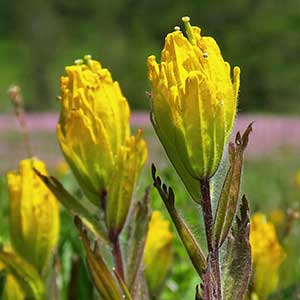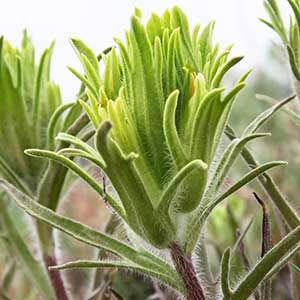Castilleja levisecta
Castilleja oresbia
golden Indian paintbrush, golden paintbrush
pale paintbrush, pale Wallowa Indian paintbrush, pale Wallowa paintbrush
few to many, erect, ± decumbent or creeping at base, unbranched, sometimes branched, hairs spreading, medium length and long, soft, mixed with short stipitate-glandular ones.
few to several, erect or ascending, sometimes decumbent at base, unbranched or branched, hairs usually retrorse, medium length, ± soft, eglandular, mixed with very short-glandular ones, sometimes with spreading, long, soft ones.
green to purple or brown-tinged, linear-lanceolate proximally, oblong-ovate or -obovate distally, 0.8–5.2 cm, not fleshy, margins plane, distalmost sometimes ± wavy, involute, 3–7(–11)-lobed, apex obtuse;
lobes erect to ascending, linear to linear-spatulate, very short, toothlike, usually arising from distal 1/3 of blade, apex rounded.
green to purple, linear to lanceolate, 2–7 cm, not fleshy, margins plane, involute, 3–5(–7)-lobed, apex acuminate to acute;
lobes spreading, linear to sometimes narrowly lanceolate, apex acute.
2.5–25 × 1–4 cm;
bracts bright yellow throughout, or proximally greenish, distally bright yellow, sometimes deep yellow-orange, especially with age, oblong, elliptic, or obtuse to ovate, (0–)5–9(–13)-lobed, sometimes wavy-margined;
lobes erect to ascending, oblong, short to medium length, arising above mid length, central lobe apex rounded, lateral ones rounded to acute.
2.5–18 × 1–3.5 cm;
bracts pale green to yellow-green or pale, dull reddish brown throughout, or proximally so colored but changing gradually to cream or yellowish on distal margins, narrowly to broadly lanceolate, (3–)5–7(–9)-lobed;
lobes ascending, linear, long, proximal lobes arising below mid length, central lobe apex obtuse, others acute.
straight or slightly curved, 17–28 mm;
tube 12–15 mm;
beak exserted, adaxially green or greenish yellow, 6–8 mm;
abaxial lip yellow or greenish, reduced, not inflated, 2–3 mm, 25–33(–50)% as long as beak;
teeth ascending to erect, yellow, 0.5–1.5 mm.
straight, 21–36 mm;
tube 16–20 mm;
teeth of abaxial lip often exserted, beak exserted;
beak adaxially green, 4.2–5.5 mm;
abaxial lip green to purple, distally white, conspicuous, slightly but noticeably pouched, often visible through front cleft, 3–5 mm, 67–100% as long as beak, puberulent;
teeth erect, white, 1.8–2.1 mm.
distally yellow, 13–22 mm;
abaxial and adaxial clefts 4–9.5 mm, 30–40% of calyx length, deeper than laterals, lateral 2.5–4.5 mm, ca. 25% of calyx length;
lobes linear to narrowly oblong or narrowly lanceolate, apex obtuse, sometimes rounded to acute.
colored as bracts, 10–25 mm;
abaxial and adaxial clefts 6–7 mm, 30–60% of calyx length, deeper than laterals, lateral 5–10 mm, 40–50% of calyx length;
lobes linear, apex acute.
= 24.
Castilleja levisecta
Castilleja oresbia
Castilleja levisecta is listed as threatened in the United States and endangered in Canada, where it is extremely rare. Most of its grassland habitat has been altered by development in the Puget Trough, and there are historical stations in the metro areas of what are now Victoria, Portland, and Seattle. For several decades, C. levisecta was considered extirpated from Oregon. However, recent reintroduction programs in Oregon and Washington have been very successful at reestablishing this species at several sites in the Willamette Valley. The bright yellow inflorescences often gradually age to a golden yellow color, unique in the genus.
Castilleja levisecta is in the Center for Plant Conservation’s National Collection of Endangered Plants.
(Discussion copyrighted by Flora of North America; reprinted with permission.)
Castilleja oresbia is endemic to eastern Oregon and adjacent Idaho. It is easily confused with both varieties of C. pallescens, which also occur in sagebrush habitats. Castilleja oresbia has longer calyx lobes and softer pubescence than C. pallescens var. pallescens, although some transitional specimens are found. Castilleja oresbia has a combination of longer calyx lobes, longer pubescence, and obscurely nerved bracts, which usually serve to separate it from C. pallescens var. inverta. All three have different, though somewhat overlapping, ranges. Castilleja oresbia occasionally hybridizes with C. peckiana in Grant County, Oregon.
(Discussion copyrighted by Flora of North America; reprinted with permission.)



